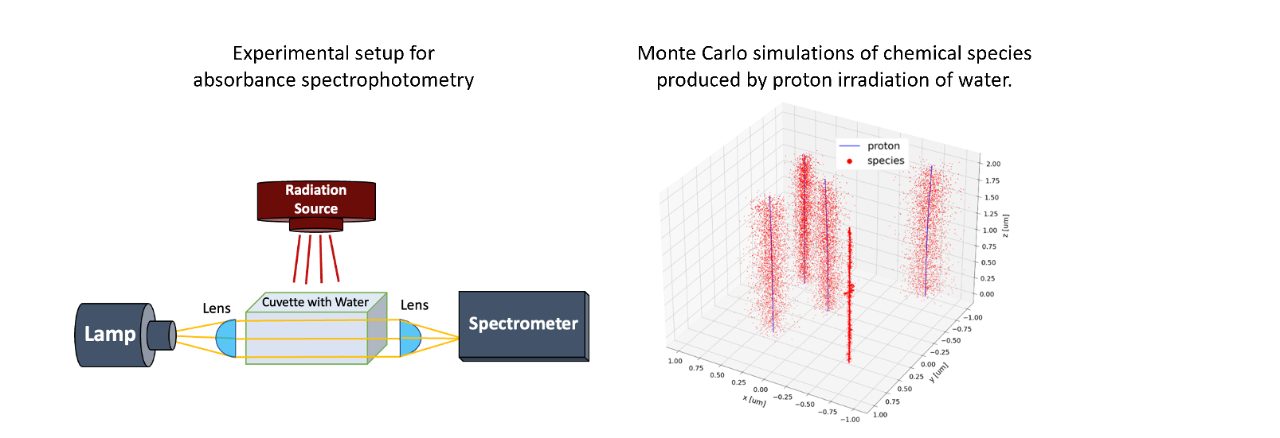Research
What is FLASH RT?
Radiation therapy (RT) treatment of malignant tumors is limited by the toxicity it causes to the healthy tissue around the tumor. Research in the past decade has shown that this normal tissue toxicity can be lessened, and in some cases completely avoided, by delivering the radiation much faster (in milliseconds instead of minutes). This sparing effect, known as the FLASH effect, is now a hot topic in the field of radiation therapy. Research groups work to provide safer, more effective, and quicker treatments with FLASH RT.
Development of FLASH beamlines for pre-clinical and clinical translation
FLASH RT is dependent on the creation and maintenance of radiation beamlines capable of achieving ultra-high dose rates, above 40 Gy/s. We explore modifications of both the hardware and software of clinical linear accelerators to increase their output and enable the delivery of consistent and accurate ultra-high dose rates. We are developing these types of systems while also bringing in commercial FLASH systems such as the FLASH Mobetron (IntraOp) and the Oriatron (PMB-Alcen) for our research efforts.
Dosimetry for FLASH RT
Measuring the dose (dosimetry) accurately in FLASH beamlines is challenging due to the extremely high dose rates and dose-per-pulse settings used, which limits the selection of viable radiation detectors. To address this issue, we are currently exploring and assessing the effectiveness of different detector systems, including beam current transformers, radiochromic film, alanine, thermoluminescent dosimeters (TLDs), and optically stimulated luminescent dosimeters (OSLDs), to precisely measure the dose and output in FLASH beamlines. Additionally, we are enhancing the capabilities of existing dosimetry systems such as ionization chambers and scintillation detectors for their use in FLASH beamlines, enabling ex-vivo and in-vivo dose measurements. Crucially, improving and utilizing existing detector systems for real-time beam monitoring and reference dosimetry in FLASH is essential to ensure the safe and reliable clinical translation of FLASH RT.

Biological effects of FLASH radiation
The biological effect of FLASH irradiation is decreased normal tissue toxicity after treatment compared to conventional radiation dose rates, while maintaining similar tumor control. One of our published findings show that whole-brain irradiation with FLASH led to better preservation of cognitive function in-vivo relative to conventional dose rate irradiation. Our present focus is found in total abdominal irradiation, showing similar sparing of the gastrointestinal tissue. The function of the gastrointestinal tract is preserved, there is less inflammation, and recovery is increased after FLASH relative to conventional irradiation.

Molecular Mechanisms of the FLASH effect
Recent evidence suggests that the underlying mechanism that causes the FLASH effect is chemical in nature, occurring in the interactions of reactive oxygen species and other molecules produced by irradiation inside cells.
We use two main approaches to investigate these interactions, which occur at the micrometer and microsecond spatial and temporal scales. Radiochemical assays as well as computational modeling techniques such as Monte Carlo simulations give us insight into what is happening at the molecular level during FLASH RT. Furthering our understanding of the mechanisms of the FLASH effect will allow us to determine optimal treatment parameters and maximize the benefits of the treatment modality while avoiding any potential side effects.

Custom Pre-clinical 3D Printing
FLASH RT experiments require numerous setups to investigate various aspects of our beam and biological subjects. These experimental setups undergo frequent changes that require unique components for accurate radiation delivery and dosimetry.
To efficiently accommodate the need for quick design and custom-fitting components, we have fostered our own in-house 3D printing program. Our design process involves using radiation interaction calculations to create custom field collimation for FLASH-RT treatments. We aim for reproducibility of radiation volumes between subjects. To accommodate this, we design novel 3D printed applicators and stereotactic apparatuses.

Future Research Directions
The overall focus of the group lies in the interface between radiation physics and radiation biology. The lab is a true multi-disciplinary lab, with backgrounds within physics, engineering, medicine, and molecular biology, all with a common goal of the development and clinical implementation of novel cancer therapies to improve and expand the arsenal of therapeutic strategies to the benefit of our current and future patients.
